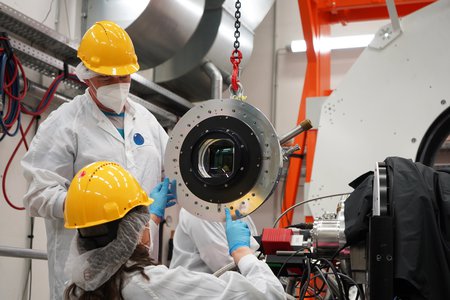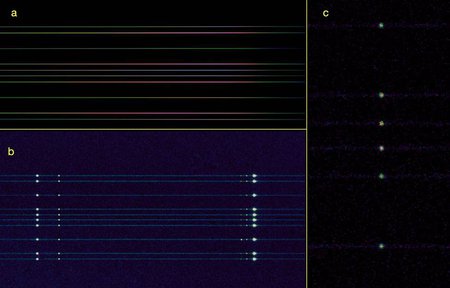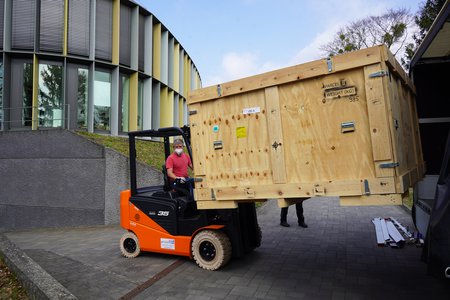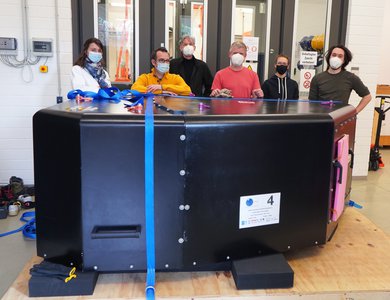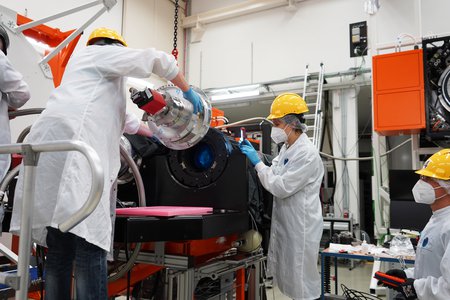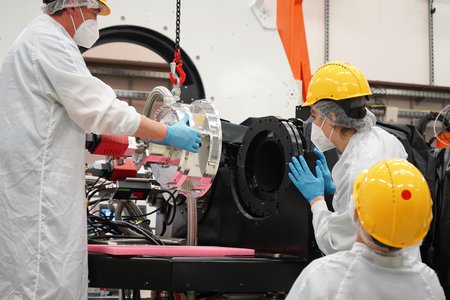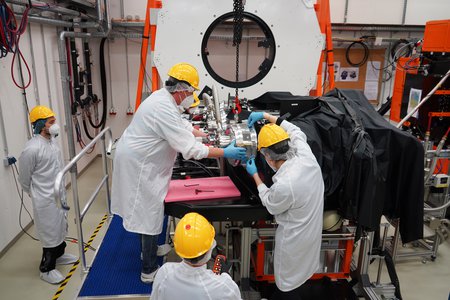4MOST spectrograph sees first light in Potsdam
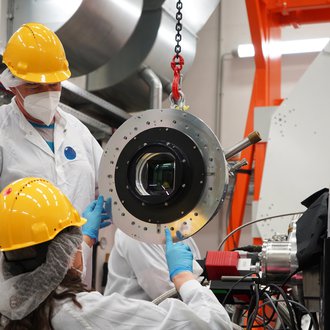
The team (CRAL, MPIA und AIP) installs the detector on the red arm of the spectrograph in the integration hall of AIP.
Credit: AIPFresh delivery from Lyon: The first of three spectrographs for 4MOST, a new innovative instrument for sky surveys being built under the leadership of the Leibniz Institute for Astrophysics Potsdam (AIP), arrived at the institute’s campus in Babelsberg. Just one week after its arrival, the low-resolution spectrograph has now produced its first spectrum after reassembly.
4MOST, the 4-metre Multi-Object Spectroscopic Telescope for the European Southern Observatory’s (ESO) VISTA telescope at Paranal in Chile, is built around three spectrographs that will measure the spectra of 2400 stars and galaxies simultaneously. Once finished at AIP’s partner institutes, all three will be sent to Potsdam for system testing and validation. Two are identical low-resolution spectrographs and one a high-resolution spectrograph. Each is fed light from the telescope by more than 800 fibres and has three arms in fixed configuration corresponding to the blue, green, and red parts of the optical spectrum, respectively. Each arm is equipped with a 36-megapixel CCD detector. The low-resolution spectrographs will provide continuous wavelength coverage from visible light to the near-infrared.
In December 2021, the first of the three spectrographs was completed at the 4MOST partner institute Centre de Recherche Astrophysique de Lyon (CRAL) in Lyon, France. After acceptance testing, it was disassembled and packed in preparation of shipment to AIP. Four trucks transported it" to the Babelsberg campus of AIP on 29 March 2022. A team of five colleagues from CRAL, supported by the local 4MOST integration team and two colleagues from the Max-Planck Institute for Astronomy (MPIA) Heidelberg unpacked the spectrograph. After reassembly, the spectrograph now saw its “first light” in Potsdam.
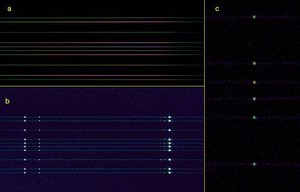
The blue camera of the low-resolution spectrograph received its first light on 5 April. The exposures are the very first ones that have been recorded, before any optimization. The performance, such as the image quality, has been judged by the team as already good and very promising.
Credit: Alban Remillieux and Florence Laurent, CRAL“The delivery and first light of the first low-resolution spectrograph is a major milestone for the 4MOST project,” highlights 4MOST project manager Joar Brynnel. „We were very excited to receive this major component and are now looking forward to its re-integration in the integration hall of AIP.” The two remaining spectrographs are scheduled for delivery in August and October of 2022.
Alban Remillieux, Project Manager for the low-resolution spectrograph from CRAL, adds: “The reintegration of the first spectrograph at AIP went rather smoothly. This success has been possible thanks to a well secured transport, which greatly eased the reassembly, and the valuable support of the local 4MOST integration team at AIP, which improved the CRAL team efficiency and reliability during reintegration.”
“Receiving the first low-resolution spectrograph in our integration hall and being able to soon mate it with the other parts of the 4MOST system is very exciting, as it gives us the first opportunity to confirm the expected performance of this unique facility,” comments 4MOST Principle Investigator Roelof de Jong. “A moment that many scientists around the world have been waiting for.”
The 4MOST consortium consists of 17 institutes in Germany, Australia, France, the Netherlands, Sweden, Switzerland, and the UK, led by AIP. 4MOST will be mounted at ESO’s VISTA telescope at Paranal in Chile. The 4MOST design allows tens of millions of spectra to be obtained via five-year surveys, even for targets distributed over a significant fraction of the sky. The instrument will also have enough wavelength coverage to secure velocities of extragalactic objects over a large range in redshift, thus enabling measurements of the evolution of galaxies and the structure of the cosmos. This exceptional instrument enables many science goals, but the design is especially intended to complement three key all-sky, space-based observatories of prime European interest: Gaia, EUCLID, and eROSITA.
Further information
More about 4MOST: https://www.4most.eu/
Images
The team (CRAL, MPIA und AIP) installs the detector on the red arm of the spectrograph in the integration hall of AIP.
Big screen size [1000 x 666, 110 KB]
Original size [6000 x 4000, 2.1 MB]
The blue camera of the low-resolution spectrograph received its first light on 5 April. The exposures are the very first ones that have been recorded, before any optimization. The performance, such as the image quality, has been judged by the team as already good and very promising.
The spectrograph was delivered to the AIP in four trucks. The picture shows the transport of the largest part into the integration hall of the institute.
Big screen size [1000 x 666, 140 KB]
Original size [6000 x 4000, 3.4 MB]
The CRAL and AIP team at the freshly delivered first spectrograph for 4MOST.
Big screen size [1000 x 767, 120 KB]
Original size [4516 x 3468, 1.5 MB]
The detector is so heavy that it is carefully moved into place with the help of the crane (the chain with hook is visible in the picture) of the integration hall.
Big screen size [1000 x 666, 130 KB]
Original size [6000 x 4000, 2.3 MB]
The team makes sure that the detector fits exactly.
Big screen size [1000 x 666, 110 KB]
Original size [6000 x 4000, 2.1 MB]
The detector is firmly screwed to the arm of the spectrograph. The third arm is now also completed with its detector.
Big screen size [1000 x 666, 140 KB]
Original size [6000 x 4000, 2.5 MB]
